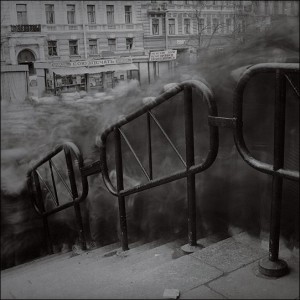Last August, Suzanne and I spent our holiday time traipsing around Normandy and Brittany. One afternoon, we found ourselves in a beautiful and unspoiled little medieval town in western Brittany looking rather aimlessly about. Having quickly found the market and the castle as well as a few other obvious “sights,” we were on the verge of running out of stuff to do. As we sought a bit of shade on a narrow little side-street, we passed a rather dilapidated old house with a hand made sign outside that said “Gallerie.” Having nothing else to do, and seeking further relief from the August heat, we stepped in. Although all décor had been removed, the space was still very much a house. Walls remained where they had been, and there were still plumbing fixtures on the walls of some rooms. The entrance of the building was all peeling paint and cracked plaster, but as we followed the signs upstairs, there were signs of recent painting (all white, of course) and wonderfully bare, old floor boards.
As it happened, there were two exhibits on, both of photography. The first was by a Russian artist I had never heard of. Within moments, though, I knew we’d stumbled onto something very special, and then, less than a minute after I entered I saw two photographs in quick succession that both gave me the exquisite, heart-in-throat feeling of experiencing art that is raw, alive, terrifying, essential- that feeling of seeing an image in the world that has been buried, unseen, in your own subconscious for all your life. The first was this one
The artist was Alexey Titarenko.
We spent the next couple of hours very quietly looking. Looking and somehow changing as we absorbed these images of life, death, despair, menace and mystery. I was so moved and impressed that I did something I never do at museums and galleries, possibly because I feared I’d never see his stuff again. I bought the book!
We kept it safe in a corner of our little car so it wouldn’t get smashed by camping equipment until we got back to Cardiff. Even then, it was a few weeks before I finally took the shrink wrap off and read the book. I was a bit nervous that the photographs couldn’t possibly be equal to that first experience where it seemed like my heart was both racing and stopping. Fortunately, these are images that endure and haunt, and I’ve enjoyed the book immensely.
Imagine, then, my reaction when I discovered that music was a huge influence on Titarenko’s work. According to the book, his picture “The Black and White of Saint Petersburg” was inspired by the Brahms Violin concerto, and that, for him each musical piece, and its conveyance of the state of mind of the composer, affects how he sees a city or a landscape. In particular, one composer seems to have had a huge influence on Titarenko’s approach and that is Dmitri Shostakovich. In particular, the Second Cello Concerto has “provided the underlying rhythm for the photographer’s inspiration.” In the artists words “I was so hooked on this concerto, that I could listen to it all day, every day. During my walks around the city, I realized that St. Petersburg offered endless living illustrations of this music. The monotonous opening cello melody was one of despair, but also of expectation. The concerto was instrumental in realizing certain images.” Fascinating. To me, this is probably the greatest cello concerto ever written. For all the glories of the Dvorak and the poignancy of the Schumann, even for Shostakovich’s own, brilliant First Concerto, to me, this work is the most essential work written for cello and orchestra, because, at least to me, its message is so important. It is music that is the singing conscience of a destroyed culture, and a very precious reminder of the frailty of humanity. It’s personal and universal messages are perfectly embodied in the juxtaposition of solo cello and orchestra. Few other works, maybe the Beethoven Violin Concerto, Berg Violin Concerto and the greatest Mozart Piano Concerti find this balance so perfectly. In any case, to what extent could my powerful reaction to Titarenko’s images be due to the fact that we shared this common love of one piece of music? How does music change us, imprint its layers of meaning on us? Perhaps I was carrying these images in my subconscious, not from birth, but from Shostakovich, or perhaps all three of us, and all of you, have always carried them inside us, but that only the true artist could bring them out into the world were we could all look or listen and say, “yes, I know this.”
More on Alexey Titarenko, including an interview in mp3 format.
c. 2006 Kenneth Woods


Recent Comments